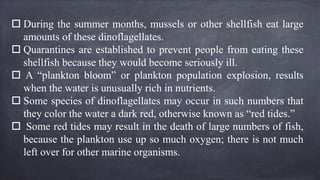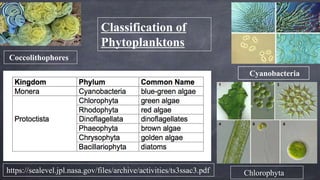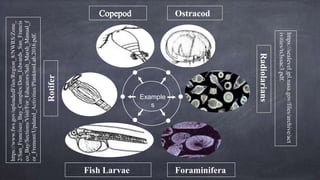This document discusses different types of plankton. It describes phytoplankton such as diatoms, dinoflagellates, coccolithophores and cyanobacteria. Diatoms are enclosed in silica cases and come in many shapes and sizes. Dinoflagellates can cause harmful algal blooms. Coccolithophores have scales and two flagella. Zooplankton include holoplankton which spend their whole lives as plankton, and meroplankton which are plankton temporarily. Examples given are copepods, ostracods and rotifers. The document also discusses using diatoms to help determine causes of death in forensic investigations.

























![• A, J. PLANKTON IDENTIFICATION. Retrieved 29 October 2020, from
https://teara.govt.nz/en/plankton/page-1.
• Levkov, Z., Tofilovska, S., & Williams, D. (2017). The use of diatoms in
forensic science: advantages and limitations of the diatom test in cases of
drowning. The Micropalaeontological Society. Retrieved 29 October 2020, from
https://www.researchgate.net/profile/Zlatko_Levkov/publication/318108836_Th
e_use_of_diatoms_in_forensic_science_advantages_and_limitations_of_the_dia
tom_test_in_cases_of_drowning/The-use-of-diatoms-in-forensic-science-
advantages-and-limitations-of-the-diatom-test-in-cases-of-drowning.pdf
• Plankton Lab. (2016). [Ebook]. Retrieved 29 October 2020, from
https://www.fws.gov/uploadedFiles/Region_8/NWRS/Zone_2/San_Francisco_B
ay_Complex/Don_Edwards_San_Francisco_Bay/Sections/Visit/For_Educators/
Salt_Marsh_Manual_for_Fremont/Updated_Activities/PlanktonLab.2016.pdf.
REFERENCES:](https://image.slidesharecdn.com/planktonsdiatomsandforensics-201210163445/85/Planktons-diatoms-and-forensics-26-320.jpg)
![• Plankton Notes. (2020). [Ebook]. Retrieved 29 October 2020, from
https://sealevel.jpl.nasa.gov/files/archive/activities/ts3ssac3.pdf
• R.,, G., Thomas, V., & Varghese, M. Phytoplankton - collection, estimation,
classification and diversity. Retrieved 1 November 2020, from
http://eprints.cmfri.org.in/10409/1/04_Molly_Vargheses1.pdf.
• Zhou, Y., Cao, Y., Huang, J., Deng, K., Ma, K., & Zhang, T. (2020). Research
advances in forensic diatom testing. Forensic Science Research, 5(2).
https://doi.org/10.1080/20961790.2020.1718901
• Cameron, N. (2004). The use of diatom analysis in forensic geoscience.
Geological Society Publications. https://doi.org/10.1144/GSL.SP.2004.232.01.25](https://image.slidesharecdn.com/planktonsdiatomsandforensics-201210163445/85/Planktons-diatoms-and-forensics-27-320.jpg)
